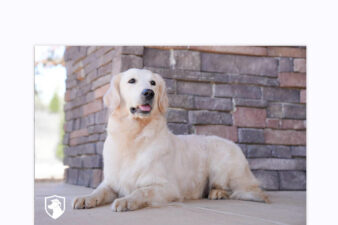Learn The English Cream Golden Retriever
What is special about English Golden Retrievers?
The materials presented below are from hours of personal study and years of experience by Recherche Goldens. First, let’s look at the most common name given to our dogs… “English Cream Golden Retriever.” There is controversy over the name. We will break it down so that it will make more sense.
“English“
This term does not mean that all English Cream Goldens are imported in from England. England has very strict quarantine laws making it very difficult to import directly from England. The truth is that all Golden Retrievers have an English origin (read the History of the Golden Retriever at the bottom of this page) and most “English Cream” Goldens are not from England at all.
Why do we call them English Cream Golden Retrievers? The reason is the standard by which they are judged. The 2 major breed standards in the Golden Retriever world today are the AKC (American Kennel Club) and the KC (British Kennel Club). Most of the world, outside of the US (and Canada) go by the KC (British Kennel Club) standards. “English Cream Golden Retrievers” is the name given to Goldens that have been bred according to the British Kennel Club standards.
The British Kennel Club and the American Kennel Club have different standards that are very pronounced today (Below we will go into detail concerning their differences). The breed’s name is the most common name given to the light colored European Goldens in America. Recherche Goldens did not make up the name. The name is of no importance…the STANDARD by which they are judged is vital.
“Cream“
Another common misconception is that all European Goldens are cream. That is not true at all. European Goldens can go from dark red to almost solid white. Recherche Goldens has chosen, out of personal taste and nothing more, to purchase light cream or white colored Goldens. We believe the cream-colored Golden Retriever has a much more beautiful look. The color has nothing to do with their health or their temperament.
Another very controversial term is “White Golden Retriever” when made in reference to the English Golden. There have been pages written on the internet criticizing the term. Is there even such thing Golden Retriever that’s white? The answer lies in your strict interpretation of “white.” Recherche Goldens have several Goldens that you would be hard pressed to deny their “white” color distinction. You couldn’t even see cream on their ears or anywhere on their body. If you put them next to a white piece of paper or freshly fallen snow, then you would see the slightest hint of color.
The truth is that almost anyone who saw the dog in person would say the Golden is white and not cream. Many breeders get caught up in semantics. Recherche Goldens have very light cream Goldens and also some Goldens that are almost white. Some people have also tried to state that there are health defects associated with the “cream” colored Golden Retriever.
As you will read below, there are scientific studies from the GRCA and the British Kennel Club disproving that color has any association whatsoever with health defects. In fact, the “English Golden” has been shown to be healthier and live longer than the American Golden Retriever, but it has nothing to do with the color of the dog.
See some of our available English Golden Puppies below:
What’s The Difference Between the American Golden Retriever & the English Golden Retriever
Health Differences
The health differences between the English Golden and the American Golden are staggering. It is the greatest reason why a serious dog seeker will consider purchasing an English Golden over an American Golden. The money saved in purchasing an American Golden pales in comparison to the vet bills accumulated over the dog’s life span.
Cancer was the cause of death for 61.8% of American Goldens according to a 1998 health study conducted by the Golden Retriever Club of America, making it the breed’s biggest killer (CLICK HERE to see the study). The most common types of cancers in Goldens are hemangiosarcoma, followed by lymphosarcoma, mast cell tumor, and osteosarcoma. The incidence of cancer among English bloodlines is significantly lower than in the American lines. In fact the British Kennel Club (KC) did a very extensive study recently and found that cancer only caused the death of 38.8% of English Goldens (CLICK HERE to see the study).
The median age of an English Golden is 12 years and 3 months according to the study, but the median age of an American Golden is only 10 years and 8 months. This means that on average an English Golden will live 1 year and 7 months longer than an American Golden and English Goldens get cancer almost 1/2 as often as American Goldens.
Temperament Differences
This is the newest section on this webpage. Only after several years of breeding and training English Golden Retrievers and interacting with hundreds of previous owners of American Golden Retrievers can we give a consistent difference in the English Cream Golden Retriever personality versus the American Golden Retriever.
First of all, Recherche Goldens have never bred or owned an American Golden Retriever. Recherche Goldens only owns imported English Goldens from the best breeders in Europe.
On the other hand, we have come in contact with dozens of American Goldens at dog shows, dog parks, veterinary hospitals, etc… We have also done stud service to American Goldens and had them live in our house for 2-3 weeks at a time. More importantly, most of our clients have owned or currently owns an American Golden Retriever. The same observations are noted by almost everyone.
It’s quite obvious that English Goldens are more often calmer than American Golden Retrievers. They are rarely hyper or high energy. Many American Golden Retrievers have a lot of energy and are very athletic. European Goldens are calmer, more mature and easier to train.
Many of European Goldens are now becoming the therapy dog of choice not only because of the health benefits but because of their calm disposition. Not all American Golden Retrievers are hyper and not all English Golden Retrievers are calm but there definitely is a CLEAR difference overall.
Color of Coat
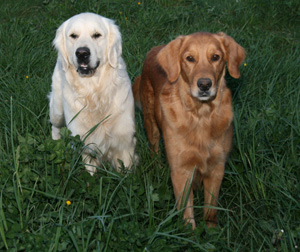 AKC: Rich, lustrous golden of various shades. Feathering may be lighter than rest of coat. With the exception of graying or whitening of face or body due to age, any white marking, other than a few white hairs on the chest, should be penalized according to its extent. Allowable light shadings are not to be confused with white markings. Predominant body color which is either extremely pale or extremely dark is undesirable. Some latitude should be given to the light puppy whose coloring shows promise of deepening with maturity. Any noticeable area of black or other off-color hair is a serious fault.
AKC: Rich, lustrous golden of various shades. Feathering may be lighter than rest of coat. With the exception of graying or whitening of face or body due to age, any white marking, other than a few white hairs on the chest, should be penalized according to its extent. Allowable light shadings are not to be confused with white markings. Predominant body color which is either extremely pale or extremely dark is undesirable. Some latitude should be given to the light puppy whose coloring shows promise of deepening with maturity. Any noticeable area of black or other off-color hair is a serious fault.
KC: Any shade of gold or cream, neither red nor mahogany. A few white hairs on chest only, permissible.
The AKC and KC standards don’t sound very different but they have definitely made a few major distinctions. AKC penalizes for the white or cream colored coats and the KC does not. Therefore, you will find many World & International cream-colored Goldens in Europe but you will never find that in an AKC show. Once again, not all English Goldens are “cream” but rarely is a highly pedigreed American Golden Retriever “cream.”
Topline & Hindquarters
AKC: Strong and level from withers to slightly sloping croup, whether standing or moving. Sloping backline, roach or sway back, flat or steep croup to be faulted.
KC: Calls for level top line. Loin and legs strong and muscular, good second thighs, well bent stifles. Hocks well let down, straight when viewed from rear, neither turning in nor out.
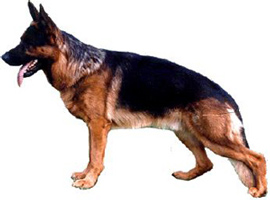

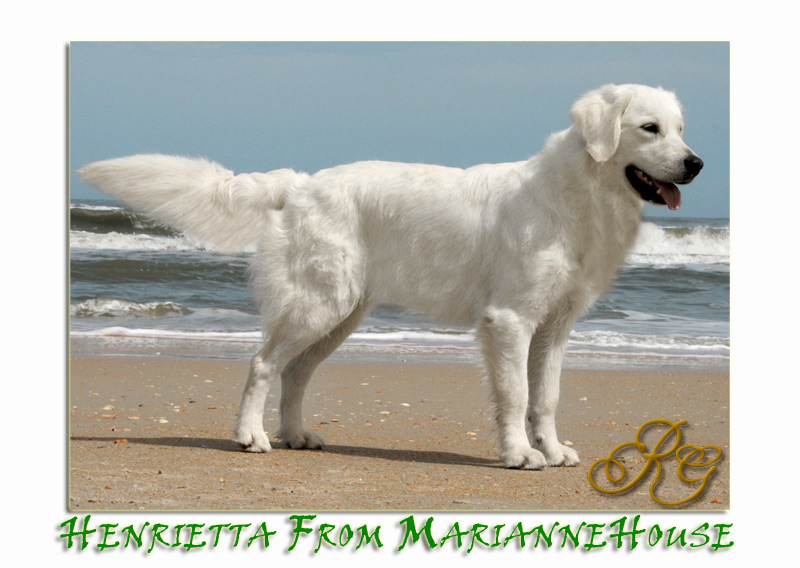
Again, the standards sound similar, but the results are quite different. English Goldens have a straighter topline than American Goldens on average. The German Shepherd in America is having the same problems. They are simply a couple of decades further down the line.
There are many German Shepard Dog breeders who want to change the standard back, but they lack reliable older type stock. The front is walking, the back looks like it is crawling.
It seems that some people want to shape a Golden Retriever this same way. This sloping tendency is not limited to just American Goldens.
Head, Neck, Eyes and Ears
AKC:
- Head- Broad in skull, slightly arched laterally and longitudinally without prominence of frontal bones (forehead) or occipital bones. Stop well defined but not abrupt. Foreface deep and wide, nearly as long as skull. Muzzle straight in profile, blending smooth and strongly into skull; when viewed in profile or from above, slightly deeper and wider at stop than at tip. No heaviness in flews. Removal of whiskers is permitted but not preferred.
- Eyes- friendly and intelligent in expression, medium/large with dark, close-fitting rims, set well apart and reasonably deep in sockets. Color preferably dark brown; medium brown acceptable. Slant eyes and narrow, triangular eyes detract from correct expression and are to be faulted.
- Ears- rather short with front edge attached well behind and just above the eye and falling close to cheek. When pulled forward, tip of ear should just cover the eye. Low, hound-like ear set to be faulted.
- Neck- medium long, merging gradually into well laid back shoulders, giving sturdy, muscular appearance. No throatiness.
KC:
- Head and Skull – Balanced and well chiseled, skull broad without coarseness; well set on neck, muzzle powerful, wide and deep. Length of foreface approximately equals length from well defined stop to occiput.
- Eyes – Dark brown, set well apart, dark rims.
- Ears – Moderate size, set on approximate level with eyes.
- Neck – Good length, clean and muscular.
In both standards there is no clear indication concerning how big the head must be in comparison to the rest of the body. These different specs somehow resulted in a generally smaller head in American Goldens than in British Goldens. This is usually more visible for males than for females.
British standard calls for a clean and muscular neck. It is perfectly understandable that for holding a bigger head, a dog will need a more muscular neck. Still, there is no mention of grooming, clipping, or whisker trimming in KC standard. And that is one of the fundamental differences. KC Standard concentrates on description of ideal specimen. The basic function of dog titles is to make its progeny spread. Trimming, clipping and other procedures are irrelevant as far as offspring of this specimen is concerned. In America, the manner of showing the dog is frequently more important than the dog itself.
Muzzle: Another very characteristic difference is foreface and muzzle. AKC standard wants the muzzle to be straight but also states the foreface should be nearly the length of the skull. This resulted in smaller muzzle and more conical shape. Despite its more laconic form, the KC standard is more precise. It wants the length of the foreface to be approximately equal to the distance between stop and occiput. English Goldens definitely have bigger and wider muzzles which influences stronger jaws.
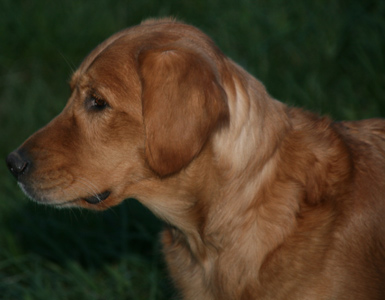
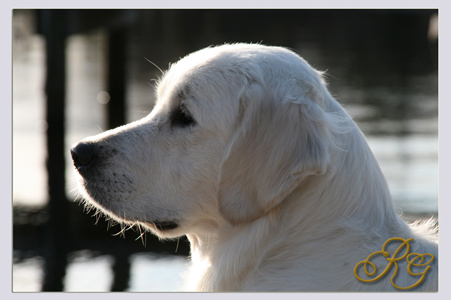
Eyes – “Pure” American Goldens usually have their eyes set very well apart, while English type usually do not. Because US Golden Retrievers’ eyes are so well apart, they tend to be slanted, narrow, triangular and detract from correct expression sometimes. In this, their eyes are defying their own standard in contrast to the British Goldens (see pictures below).
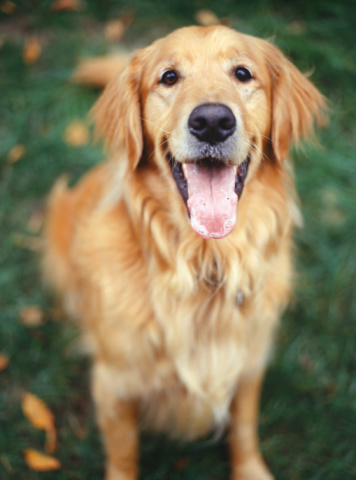
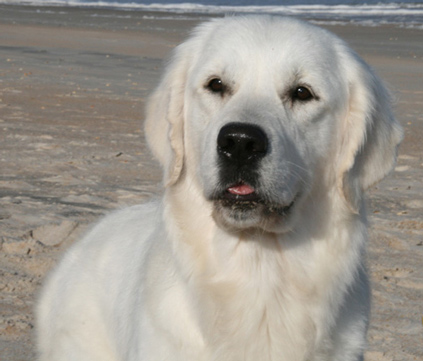
Ears and specifically their position are another point of difference between the two types of goldens. AKC wants ears well behind and above the level of eyes. KC wants them at the level of eyes. This causes two very different looks. See pictures below.
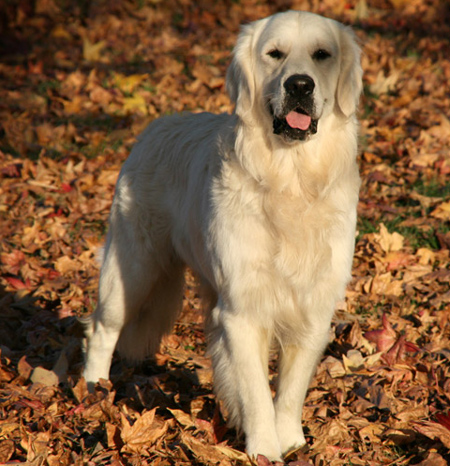
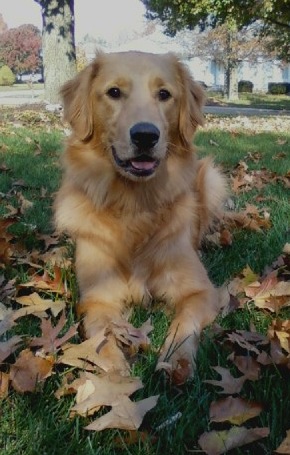
English-type Goldens are bigger-boned and shorter, with a more square head and or muzzle and are generally slightly heavier. The British Kennel Club standard calls for a level topline and straight hindquarters without the slight rear angulation found in American lines. The eyes of American line dogs tend to be set further apart than those of British lines and can appear to be slanted and triangular in shape by comparison.
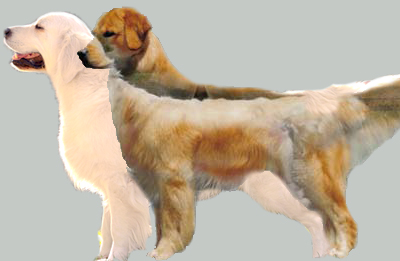
Characteristics Of The Golden Retriever
The temperament of the Golden Retriever is a hallmark of the breed and is described in the standard as “kindly, friendly and confident.” They are not “one man dogs” and are generally equally amiable with both strangers and those familiar to them. Their trusting, gentle disposition therefore makes them a poor guard dog.
Any form of unprovoked aggression or hostility towards either people, dogs or other animals, whether in the show ring or community, is completely unacceptable in a Golden Retriever and is not in keeping with the character of the breed and as such is considered a serious fault. On the other hand, a Golden Retriever shouldn’t be unduly timid or nervous either.
The typical Golden Retriever is calm, naturally intelligent and biddable, with an exceptional eagerness to please. Whether the object is a thrown stick, tennis ball, or flying disc, retrieving can keep a dog of this breed occupied and entertained for hours, particularly if water is also involved. Goldens might also pick up and “retrieve” any object that is near to them upon their masters’ arrival, all of this lending to their retriever name.
Golden Retrievers are also noted for their intelligence, and can learn up to roughly 240 commands, words and phrases. The Golden Retriever ranks 4th in Stanley Coren’s The Intelligence of Dogs, being one the the brightest dogs ranked by obedience command trainability. These dogs are also renowned for their patience with children.
By the time they reach maturity however, Goldens will have become active and fun-loving animals with the exceptionally patient demeanor befitting a dog bred to sit quietly for hours in a hunting blind. Adult Golden Retrievers love to work, and have a keen ability to focus on a given task. They will seemingly work until collapse, so care should be taken to avoid overworking them.
Other characteristics related to their hunting heritage are a size suited for scrambling in and out of boats and an inordinate love for water. Golden Retrievers are exceptionally trainable—due to their intelligence, athleticism and desire to please their handlers—and generally excel in obedience trials. In fact, the first AKC Obedience Trial Champion was a Golden Retriever. They are also very competitive in agility and other performance events. Harsh training methods are unnecessary – Golden Retrievers respond well to positive and upbeat training styles.
Golden Retrievers are compatible with children and adults and are good with other dogs, cats and most livestock. Golden Retrievers are particularly valued for their high level of sociability towards people, calmness, and willingness to learn. Because of this, they are commonly used as guide dogs, mobility assistance dogs, and search and rescue dogs. They are friendly and tend to learn tricks easily.
They are also known to become excellent surrogate mothers to different species. Kittens and even tiger cubs from zoos are well taken care of by golden retrievers. In some cases, a retriever may produce milk for its adopted even though it may not have been pregnant or nursing recently.
Ready to learn more about adding one of these dogs to your family? Come to Recherche Goldens for the best in English Cream Golden Retriever puppies for sale. View our available puppies online, and contact us today!
Golden Retrievers are very active dogs, and require a reasonable amount of exercise each day, although exercise needs may vary depending on the individual dog and its age. They are a breed that is prone to obesity, and as such the average Golden Retriever should never be treated like a sedentary small dog. Some dogs may be too active to be easily exercised by elderly owners. They should be taken on walks daily.
Goldens should be groomed at least once a week, and every day during heavy shedding. Their coats shed somewhat during the year, but are known to “blow coat” twice a year when they shed profusely. They also need to have their ears cleaned regularly, or otherwise an ear infection might occur. While shedding is unavoidable with Golden Retrievers, frequent brushing (daily to weekly) lessens the amount of hair shed by the animal. Severe shedding resulting in bald patches can be indicative of stress or sickness in a Golden Retriever.
Golden Retrievers are very attached to their owners. They are highly social house dogs, seek to sleep in the same room as their owners, and should not be put into kennels for protracted periods. Leaving them alone in a room can cause the dog to become anxious and distressed. The dogs like to have something in their mouth and carry things around and should for this reason be provided with a copious supply of favorite toys — the particular obsession of which depends upon the individual animal.
The Golden Retriever breed was originally developed in Scotland and England at “Guisachan” near Glen Affric, the highland estate of Sir Dudley Marjoribanks, later Baron Tweedmouth. For many years, there was controversy over which breeds were originally crossed. In 1952, the publication of Majoribanks’ breeding records from 1835 to 1890 dispelled the myth concerning the purchase of a whole troupe of Russian sheepdogs from a visiting circus.
Improvements in guns during the 1800s resulted in more fowl being downed during hunts at greater distances and over increasingly difficult terrain. This led to more birds being lost in the field. Because of this improvement in firearms, a need for a specialist retriever arose as training setter and pointer breeds in retrieval was found to be ineffective. Thus work began on the breeding of the Golden Retriever to fill this role.
Some Goldens excel at retrieving in water; others only wade up to their bellies. The original cross was of a yellow-coloured Retriever, Nous, with a Tweed Water Spaniel female dog, Belle. The Tweed Water Spaniel is now extinct but was then common in the border country. Majoribanks had purchased Nous in 1865 from an unregistered litter of otherwise black wavy-coated retriever pups. In 1868, this cross produced a litter that included four pups; these four became the basis of a breeding program which included the Irish Setter, the sandy-colored Bloodhound, the St. John’s Water Dog of Newfoundland, and two more wavy-coated black Retrievers.
The bloodline was also inbred and selected for trueness to Majoribanks’ idea of the ultimate hunting dog. His vision included a more vigorous and powerful dog than previous retrievers, one that would still be gentle and trainable. Russian sheepdogs are not mentioned in these records, nor are any other working dog breeds. The ancestry of the Golden Retriever is all sporting dogs, in line with Majoribanks’ goals.
Golden Retrievers were first accepted for registration by the The Kennel Club (KC) of England in 1903, as Flat Coats – Golden. They were first exhibited in 1908, and in 1911 were recognized as a breed described as Retriever (Golden and Yellow). In 1913, the Golden Retriever Club was founded. The breed name was officially changed to Golden Retriever in 1920.
The Honorable Archie Majoribanks took a Golden Retriever to Canada in 1881, and registered Lady with the American Kennel Club (AKC) in 1894. These are the first records of the breed in these two countries. The breed was first registered in Canada in 1927, and the Golden Retriever Club of Ontario, now the Golden Retriever Club of Canada, was formed in 1958. The co-founders of the GRCC were Cliff Drysdale an Englishman who had brought over an English Golden and Jutta Baker, daughter in law of Louis Baker who owned Northland Kennels, possibly Canada’s first kennel dedicated to Goldens. The AKC recognized the breed in 1925, and in 1938 the Golden Retriever Club of America was formed.
The median life span for Golden Retrievers is approximately 10 to 12 years. They do very well in small living areas of at least 500 sf. While the breed is recognized for its vitality, many retrievers are susceptible to specific ailments. A responsible breeder will proactively minimize the risk of illness by having the health of dogs in breeding pairs professionally assessed and selected on the basis of complementary traits.
Breeding Golden Retrievers can be profitable for puppy mills and backyard breeders. As a result of careless breeding for profit, Goldens are prone to genetic disorders and other diseases. Hip dysplasia is very common in the breed; when buying a puppy in the US the parents should be examined for hip disease by the BVA (British Veterinary Association), PennHip, OVC (Ontario Veterinarian College), FCI or OFA.
